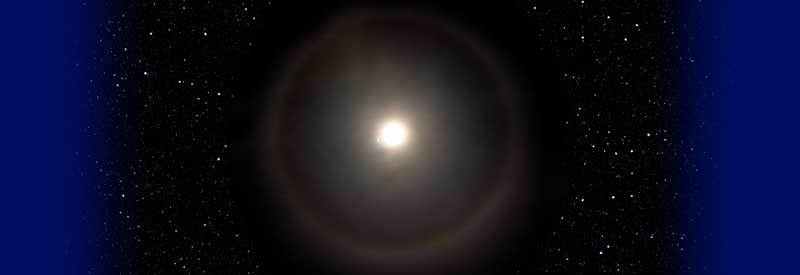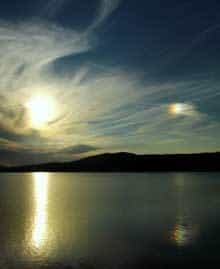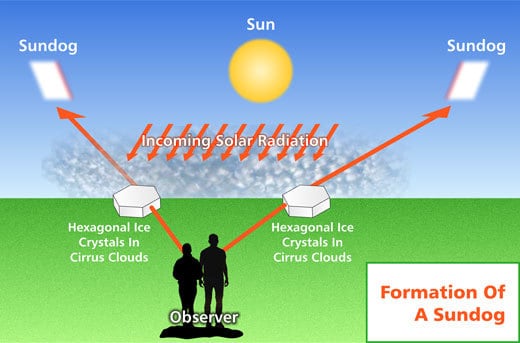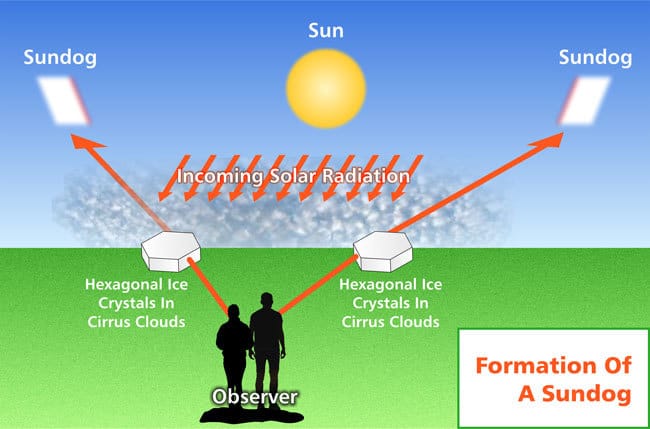Defining A Sundog Or Parhelion And How It Occurs

On some rare occasions, while looking at the horizon during sunset or sunrise, one can observe what looks like "multiple suns." We take a closer look at this meteorological phenomenon known as a sundog.
A sundog or parhelion is defined as a bright optical phenomenon occurring near the horizon on the left, right, or both sides of the sun at a 22-degree radius. It is a result of sunlight refracted by hexagon-shaped ice crystals in Cirrus clouds with their primary axis vertically orientated.
A sundog (or sun dog) is part of a family of optical meteorological phenomena that occurs as a result of sunlight or moonlight being refracted (bent) by ice crystals in high-altitude Cirrus clouds that observers view as different shapes and displays.
The spectacular and more familiar solar halo (or ring around the sun) is the same phenomenon, as well as sun pillars, which also occur close to the horizon. They appear differently, though, partly due to the orientation of the ice crystals and the sun's position.
In this article, we examine what a sundog is and how it is created. We also look at its characteristics and highlight the important facts about this phenomenon.
Sundog Definition
During the introduction, a brief description of what a sundog is was already provided. In order to best understand its characteristics and formation, though, one first needs to establish a more detailed definition:
What Is A Sundog?

A sundog (also known as a parhelion or mock sun) is a bright optical phenomenon that occurs near the horizon to the left and/or right side of the sun at a radius of 22 degrees.
It is caused by sunlight being refracted by six-sided (hexagon-shaped) ice crystals in high-altitude Cirrus clouds with their primary axis vertically orientated.
A sundog (sun dog) is officially known as a parhelion but is also referred to as a mock sun.
The word "parhelion" is derived from the Greek "para-" (meaning beside) and "-hēlios" (referring to the sun). Literally translated, it means "beside the sun," which is exactly where sundogs are situated.
The name "sun dog" also originated in Greek Mythology, where it was believed that Zeus walked his dogs across the sky. Consequently, sundogs represent the dogs of Zeus.
As already mentioned, a sundog is the result of light being refracted through hexagonal ice crystals in Cirrus clouds. But it is not only the hexagonal shape of the crystals that allows for the formation of this phenomenon.

The crystals also have a flat, plate-shaped form, which allows them to float horizontally in the air and create the appearance of a sundog on one or both sides of the sun. (As opposed to a solar halo where the ice crystals are more randomly orientated.)
Consequently, these horizontally orientated crystals cause the sunlight to bend through a 22° angle towards the observer and also break it up into its primary colors.
As a result, the inside edge of a sundog has a red-colored tint, while the rest of the colors blend together to reform the bright white color of the sun. Sometimes, though, a faint blue color forms on its outer edge, and at times the phenomenon displays the full array of rainbow colors.
A sundog is not visible to everyone where the sun shines through Cirrus clouds. It depends on your physical location in relation to the position of the sun. Depending on your position, the ice crystals refract the light from the sun at just the right angle to see the occurrence.
What Causes Sundog
As mentioned in the previous section, the rings you see around the sun result from the ice crystals in cirrus clouds refracting and reflecting the light in such a way that you can see a ring appearing from your location on the planet's surface.

Illustration describing the formation of a sundog. Click on the image for a larger, more detailed view.
A few things need to be in place in order, though, to observe sundogs beside the sun clearly.
- The sun needs to be close to the horizon in a mostly clear sky.
- 2Secondly, a relatively clear sky with only a thin layer of cirrus clouds high up in the atmosphere is essential. (Due to the Earth's natural curvature, it will appear to be hovering over the horizon.)
- 3As sunlight reaches the cirrus clouds close to the horizon (from the observer's perspective), it gets refracted and "bend" by the ice crystals.
- 4The refraction by the ice crystals causes the light to be projected in a different direction.
- 5If the light is refracted or "bend" at a 22-degree angle, the sundog will become visible to the observer. (This also means the sundog is situated at a radius of about 22 degrees to the side of the sun.)
As mentioned, a sundog is not always visible to anyone viewing the sun through a layer of cirrus clouds near the horizon. One has to be in the right location on the planet in relation to the sun's location, with plate-shaped ice crystals in the clouds also orientated correctly.
Facts And Characteristics Defining A Sundog
The following list summarizes and highlights some of the key facts and characteristics regarding a sundog, some of which have already been explained in more detail elsewhere in this article:
- A sundog is an optical meteorological phenomenon that occurs near the horizon to the left and/or right side of the sun.
- 2It is the result of plate-shaped hexagonal icy crystals in high-altitude cirrus clouds refracting sunlight towards the observer.
- 3A sundog (sun dog) is officially referred to as a parhelion but is also known as a mock sun.
- 4It is the same type of meteorological phenomenon as a solar halo, and it's not uncommon for the two to appear together at a radius of 22 degrees from the sun.
- 5It has a predominantly bright white color, but since ice crystals break up the sunlight into its primary colors, sundogs usually have a red tint on their inner boundary (facing the sun).
- 6As a result of ice crystals breaking up sunlight into its primary colors (like a prism), a sundog occasionally displays the full range of colors similar to a rainbow.
- 7A sundog is a phenomenon that also occurs on other planets in our solar system like Saturn, Neptune, and Jupiter.
- 8Sundogs are named after the "dogs of Zeus in Greek" Mythology.
This is by no means an exhaustive and complete list but focused on the key aspects that define a sundog (or parhelion).
Conclusion
As this article clearly highlighted, the "mock sun" appearing on one or both sides of the sun is not an abnormal or inexplicable event.
It has a logical and scientific explanation for its occurrence, which has everything to do with what is going on in our own atmosphere, and nothing with what is happening in space around the sun itself.
It is also worth mentioning again that the ring one sometimes observes around the sun (solar halo) is also exactly the same type of phenomenon as a sundog.
Never miss out again when another interesting and helpful article is released and stay updated, while also receiving helpful tips & information by simply clicking on this link .
Until next time, keep your eye on the weather!


